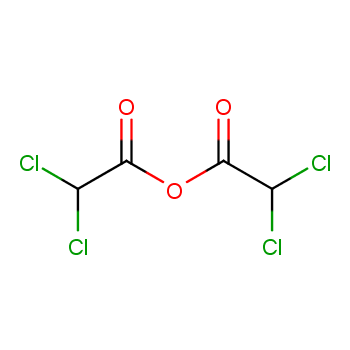 |
 |
clear colorless liquid after melting
View more+2,2-Dichloroacetic anhydride 2,2-Dichloroacetyl 2,2-dichloroacetate Acetic acid, 2,2-dichloro-, 1,1′-anhydride Acetic acid, dichloro-, anhydride Aceticacid,dichloro-,anhydride Anhydrid kyseliny dichloroctove anhydridkyselinydichloroctove Dichloroacetetic anhydride Dichloroacetic acid anhydride dichloro-aceticacianhydride dichloro-aceticacid-anhydride NSC 401832



Reported in EPA TSCA Inventory.
Safety Information of Dichloroacetic anhydride (CAS NO.4124-30-5):
Hazard Codes: C![]()
Risk Statements: 20/21/22-34
20: Harmful by inhalation
21: Harmful in contact with skin
22: Harmful if swallowed
34: Causes burns
Safety Statements: 26-27-28-36/37/39-45
26: In case of contact with eyes, rinse immediately with plenty of water and seek medical advice
27: Take off immediately all contaminated clothing
28: After contact with skin, wash immediately with plenty of ... (to be specified by the manufacturer)
36: Wear suitable protective clothing
37: Wear suitable gloves
39: Wear eye/face protection
45: In case of accident or if you feel unwell, seek medical advice immediately (show label where possible)
Dichloroacetic anhydride ,its CAS NO. is 4124-30-5,the synonyms is Acetic acid, dichloro-, anhydride ; Aceticacid,dichloro-,anhydride ; Anhydrid kyseliny dichloroctove ; Anhydridkyselinydichloroctove ; Dichloroacetetic anhydride ; Dichloroacetic acid anhydride ; Dichloro-aceticacianhydride ; Dichloro-aceticacid-anhydride .
| 1. |
skn-rbt 10 mg/24H open MOD |
AMIHBC AMA Archives of Industrial Hygiene and Occupational Medicine. 4 (1951),119. | ||
| 2. |
eye-rbt 50 µg open SEV |
AMIHBC AMA Archives of Industrial Hygiene and Occupational Medicine. 4 (1951),119. | ||
| 3. |
orl-rat LD50:2820 mg/kg |
AMIHBC AMA Archives of Industrial Hygiene and Occupational Medicine. 4 (1951),119. | ||
| 4. |
skn-rbt LD50:470 mg/kg |
AMIHBC AMA Archives of Industrial Hygiene and Occupational Medicine. 4 (1951),119. |
Acute toxicity - Dermal, Category 3
Skin corrosion, Category 1B
Acute toxicity - Inhalation, Category 4
| Pictogram(s) |   |
|---|---|
| Signal word | Danger |
| Hazard statement(s) | H311 Toxic in contact with skin H314 Causes severe skin burns and eye damage H332 Harmful if inhaled |
| Precautionary statement(s) | |
| Prevention | P280 Wear protective gloves/protective clothing/eye protection/face protection. P260 Do not breathe dust/fume/gas/mist/vapours/spray. P264 Wash ... thoroughly after handling. P261 Avoid breathing dust/fume/gas/mist/vapours/spray. P271 Use only outdoors or in a well-ventilated area. |
| Response | P302+P352 IF ON SKIN: Wash with plenty of water/... P312 Call a POISON CENTER/doctor/…if you feel unwell. P321 Specific treatment (see ... on this label). P361+P364 Take off immediately all contaminated clothing and wash it before reuse. P301+P330+P331 IF SWALLOWED: Rinse mouth. Do NOT induce vomiting. P303+P361+P353 IF ON SKIN (or hair): Take off immediately all contaminated clothing. Rinse skin with water [or shower]. P363 Wash contaminated clothing before reuse. P304+P340 IF INHALED: Remove person to fresh air and keep comfortable for breathing. P310 Immediately call a POISON CENTER/doctor/… P305+P351+P338 IF IN EYES: Rinse cautiously with water for several minutes. Remove contact lenses, if present and easy to do. Continue rinsing. |
| Storage | P405 Store locked up. |
| Disposal | P501 Dispose of contents/container to ... |
none
 |
 |
 |

|